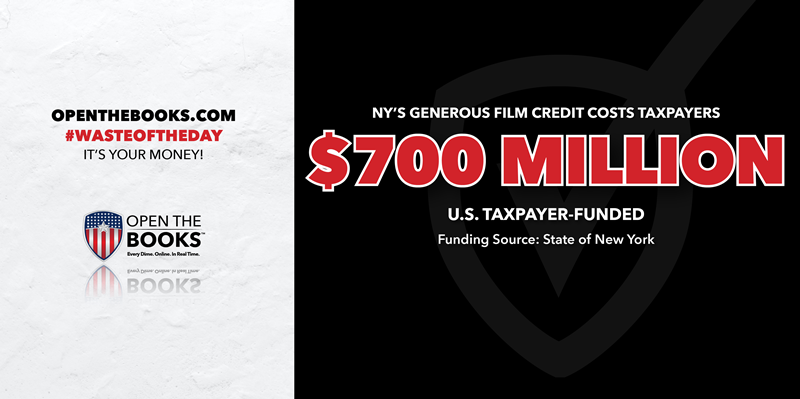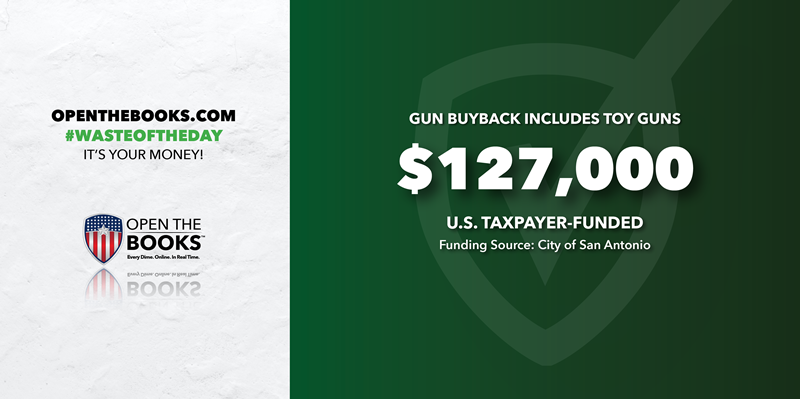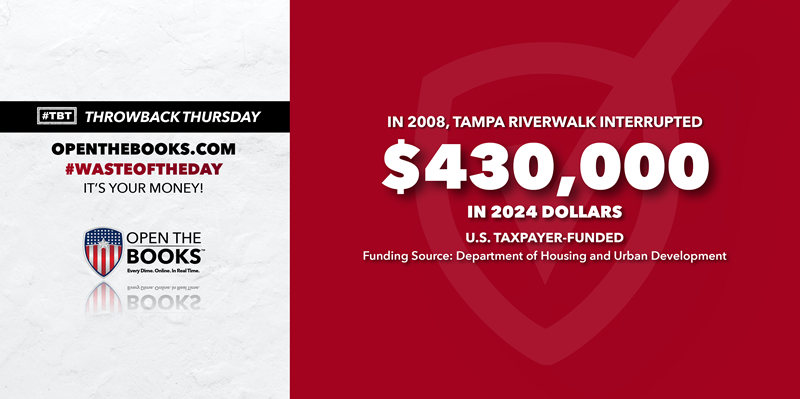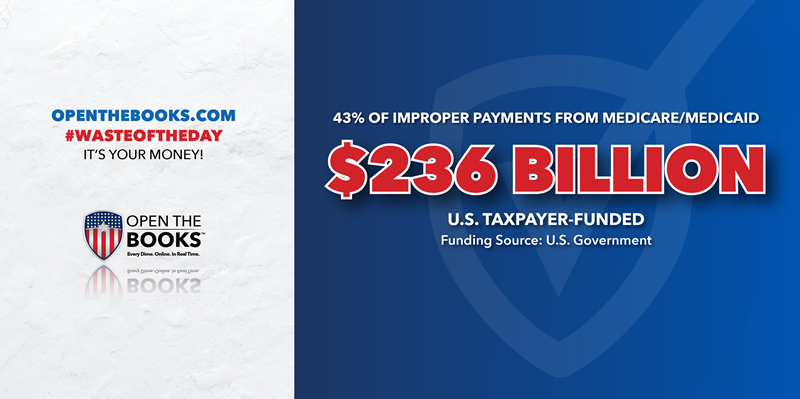
NY’s $700 Million Film Credit a 'Net Cost' To State
March 11, 2024

Topline: New York State’s subsidies for film producers cost $700 million last year but didn’t boost revenue nearly enough to cover their cost, according to a reviewcommissioned by the state’s Department of Taxation and Finance.
Key facts: The Empire State Film Production Tax Credit pays for 30% of the costs of movies and TV shows filmed in New York, theoretically encouraging producers to create jobs in the state. It’s one of the largest industry-specific tax credits in America.
The subsidy has cost taxpayers almost $7 billion in the last 20 years, and a recent increase means it will cost an estimated $7.7 billion in the next 10 years.
It’s supposed to pay for itself by boosting revenue and collecting income tax on film producers. But the credit is actually generating only 31 cents of tax revenue for every dollar spent, according to the new study.
PFM Group Consulting, which authored the study, wrote that “Based on an objective weighing of the costs and benefits, the film production credit is at best a break-even proposition and more likely a net cost to NYS.”
The credits are “fully refundable,” making them “effectively the same as a grant” since producers can get the money even if they’re not paying taxes to the state.
Proponents of the tax credit argue that without it, film producers would leave for other subsidized states such as New Jersey and Georgia, as well as Canada. The PFM study does not offer a direct stance on this opinion, but its authors wrote that “It’s also quite likely that a lot of activity would occur in this industry in [New York] with or without the incentives.”
Background: The film tax credit used to cost $420 million per year, until a bill backed by Gov. Kathy Hochul expanded it by 70% last year.
Notable payouts have included a $15.7 million subsidy for the “John Wick” franchise and $14 million for the TV series “Unbreakable Kimmy Schmidt,” per the New York Times.
Supporting quote: In an October statement, Hochul wrote that the film tax credit “has generated over $20 billion in spending and created 57,300 direct and indirect jobs in the Empire State.”
Critical quote: “PFM’s findings are likely to be ignored by the Hochul administration and the Legislature’s Democratic supermajorities,” E.J. McMahon of the Empire Center for Public Policy wrote.
“The taxpayer giveaway to Hollywood East enjoys strong support from a politically powerful, deep-pocketed constellation of producers, actors, labor unions and real estate interests enriched by the subsidy. The film credit’s cheerleaders aren’t just a reliable source of big campaign contributions — they can even arrange for a governor to receive a special Emmy Award,” referring to the award that former Gov. Andrew Cuomo won in 2020 for his televised press conferences during the pandemic.
Summary: The Empire State Film Production Tax Credit exists to boost revenue and create jobs for New York, not just to help movies get made. If it isn’t accomplishing that goal, it’s nothing more than the world’s most expensive Netflix subscription.
U.S. Navy Spent $4.3 Million To Play Fortnite, Other Games
March 12, 2024

Topline: The U.S. Navy spent $4.3 million last year on recruitment efforts using Esports and video games, including paying officers to play Fortnite with teenagers, according to reporting from The Guardian.
Key facts: The Navy’s Fortnite team — which plays a popular shooting game with an estimated 30 million daily users — is called “Goats & Glory.” Its 12 members think of themselves as the “Blue Angels of Esports” in that they try to get people curious about joining the military.
The Navy has already posted almost two dozen videos this year of Goats & Glory playing online video games against children for up to four hours at a time, all while collecting a military salary. The team even has its own dedicated facility in Memphis, Tennessee.
A spokesperson told The Guardian that the Navy spends as much as 5% of its advertising budget on Esports.
A 2022 job listing for Goats & Glory says that “a typical day includes practicing playing, live-streaming and setting up tournaments” from 8 a.m. to 4 p.m.
The Air Force and Coast Guard also have their own Esports teams who stream videos of themselves playing video games, hoping to encourage young people to one day join the military. The Army and Navy hold tournaments for popular games such as Valorant, another shooting game.
The military puts its gaming content on several platforms such as YouTube and Discord. The Navy reached over 1 million viewers on the website Twitch last year.
The practice has been going on for years. In 2020, the Navy dropped its Super Bowl ad to devote more money to Esports.
Critics warn that these initiatives can glamorize the violence of the military. The issue has even come up in Congress, with Rep. Alexandria Ocasio-Cortez (D-NY) trying to ban the Army from streaming video games.
Background: Esports aren’t the only way the military is spending money to affect young minds.
OpenTheBooks recently reported that the Department of Defense Education Activity implemented a controversial Diversity Equity and Inclusion curriculum in its schools, despite publicly indicating that the curriculum would be dismantled.
Last year, former Under Secretary for Military Readiness Gil Cisernos said the Pentagon was nixing its DEI department. But OpenTheBooks found through a Freedom of Information Act request that the department was just incorporated into other military areas, while info on DEI was removed from Pentagon websites in response to negative media attention.
Summary: Military recruitment is important for our nation’s future, but perhaps there are better ways for Navy staff to protect our country than playing Fortnite with teenagers.
San Antonio Spends $127,000 on Gun Buyback That Includes Toys
March 13, 2024

Topline: The San Antonio Police Department’s latest safety campaign spent over $127,000 to coax residents’ guns out of their hands, and ended up purchasing toy and BB guns along the way.
Key facts: San Antonio’s first-ever gun buyback program paid Texans to give up their firearms, collecting 906 guns in exchange for up to $300 of credit at H-E-B grocery store.
The event was “never intended to lower crime” but to “help people feel safe, and to reduce the number of weapons that could get into circulation that could be used for crime,” according to Councilman and mayoral candidate John Courage, News 4 San Antonio reported.
But records obtained by the TV station revealed that the police paid for three toy guns and 16 pellet guns.
Those weapons are the sort that would shoot Ralphie’s eye out in “A Christmas Story,” not the kind that police need to spend six figures to protect the public from.
Courage explained that “anything that even looks like the gun can be a danger to people in the public,” because kids could injure themselves or scare others while trying to commit a crime with a toy gun.
The program had a stated budget of $100,000, but News 4 found that it actually cost tens of thousands more than that. The 51 police officers working the event were also paid $27,333 in salary, including overtime.
The police destroyed all the firearms, including some with high resale value or with historical significance.
Courage said he hoped to continue the program in the future.
Background: San Antonio might be paying to destroy guns, but that doesn’t mean the city hasn’t been spending money on its own weaponry.
The city has spent $222,800 at Bailey’s Firearms Country since 2019, according to records at OpenTheBooks.com.
San Antonio police officers are also highly compensated, with some salaries approaching $300,000 in 2022. That year, 106 people in the city made more than $200,000; 46 of them were police officers.
Supporting quote: "If we help people go out and buy a Thanksgiving dinner for their family, or allowed them to go out and buy toys for their grandchildren or children at Christmas time, that's a great return on the investment of no longer keeping something in your home that you didn't want that might - you might feel as unsafe," Courage said.
Critical quote: "Whether it was John Courage saying it was just for people to feel better, or it was even the Chief of Police saying that it's a program that doesn't work - a program that doesn't work shouldn't be the recipient of government funds," mayoral candidate Brandon Herrera said. "It shouldn't be what the city is paying for."
Summary: The Second Amendment doesn’t explicitly guarantee the right to bear toy guns, but common sense should have been enough to guide the San Antonio police in this scenario.
Throwback Thursday: Trump Building Stopped, Taxpayers Left With Bill
March 14, 2024

Throwback Thursday!
Topline: In 2008, a 450-foot segment of the Tampa Riverwalk in Florida was supposed to be completed with private funding.
That was until businessman Donald Trump sued to stop the construction of the eponymous condominium development, “Trump Tower Tampa,” leaving the adjacent Riverwalk short on cash and in need of $294,000 from the federal government, or $430,000 in 2024 dollars.
That’s according to the “Wastebook” reporting published by the late U.S. Senator Dr. Tom Coburn. For years, these reports shined a white-hot spotlight on federal frauds and taxpayer abuses.
Coburn, the legendary U.S. Senator from Oklahoma, earned the nickname "Dr. No" by stopping thousands of pork-barrel projects using the Senate rules. Projects that he couldn't stop, Coburn included in his oversight reports.
Coburn's Wastebook 2008 included 65 examples of outrageous spending worth more than $1.3 billion, including the $294,000 in funding for the Riverwalk.
Key facts: The Tampa Riverwalk was set to begin the next phase of its construction in early 2007. Florida’s then-Gov. Charlie Crist had approved $2 million in funding, and private developer SimDag LLC had promised to build “Trump Tower Tampa,” a 52-story condominium that would be the tallest building in the city.
A city ordinance requires developers who are building along the Riverwalk's 2.3-mile stretch to pay for segments at their properties, according to the Tampa Tribune.
Trump had no role in the condo project; SimDag was paying him to attach his name and celebrity to the building. Both parties kept this secret, and Floridians began buying the future condos under the belief that Trump owned the building.
But before construction began, the plan hit a snag. The housing market was crashing, and limestone found at the construction site needed to be (expensively) cleared away.
Soon, SimDag had no more money to pay Trump. He sued to stop them from building the tower with his name, and construction never got past foundation footings.
SimDag also disconnected its phone lines, leaving customers unable to get back the deposits they had made on units that would never be built. Dozens of lawsuits were filed against Trump and SimDag.
That left an entire section of the Riverwalk unfunded, meaning development would need to stop. The Department of Housing and Urban Development sent $294,000 of taxpayer funds to help construction continue.
Tampa residents contributed 14% in those years, with the city adding more of its own money in later years.
Summary: Today, the 2.6-mile Riverwalk includes an aquarium, an art museum and more. The city spent $38 million last year to expand the Tampa Convention Center into the area once designated for Trump Tower.
Medicaid and Medicare Remain Biggest Culprits for Improper Payments
March 15, 2024

Topline: The federal government spent $236 billion on improper payments in 2023, according to a recent audit from the U.S. Government Accountability Office.
Medicaid and Medicare were responsible for $101.5 billion of the payments (43%). Auditors at OpenTheBooks have continuously warned about financial mismanagement at the two agencies, most recently publishing an oversight report in 2023.
Key facts: Improper payments are payments the government accidentally sends to the wrong person or for the wrong amount.
Last year, OpenTheBooks reported that the federal government had made $2.9 trillion in improper payments between 2004 and 2022, adjusted for inflation. The GAO’s new data brings the total well above $3 trillion. That’s more than 10% of America’s current GDP, all given away by mistake.
OpenTheBooks’ previous reports also found that Medicaid and Medicare improper payments have skyrocketed since totaling “only” $64 billion in 2012. The agencies’ 2023 total isn’t quite as high as in the two previous years, but it’s still $16 billion higher than in 2012, adjusted for inflation.
The third-worst program belonged to the Department of Labor, which sent $43.6 billion in improper payments for pandemic unemployment assistance.
Sixteen programs reported improper payment rates above 10%. Under federal law, those programs must submit a plan to Congress with steps to address the issue, since they are demonstrating poor “fraud risk management.”
Not every program estimated its improper payments, so the actual amount is likely even greater than $236 billion. Regardless, the figure is still higher than the total annual budget of any U.S. state besides California.
Critical quote: “We identified … the federal government’s inability to determine the full extent to which improper payments occur and reasonably assure that appropriate actions are taken to reduce them,” the GAO wrote in its report. “Until the federal government has implemented effective processes to determine the full extent to which improper payments occur … it will not have reasonable assurance that the use of federal funds is adequately safeguarded.”
Summary: Most national governments don’t see $236 billion total in an entire year. The U.S. government threw out that much by mistake.
The #WasteOfTheDay is presented by the forensic auditors at OpenTheBooks.com.